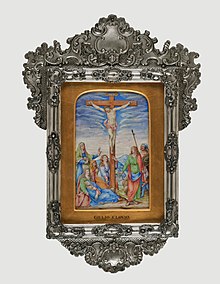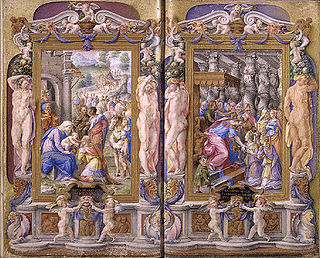Giulio Clovio Juraj Julije Klović | |
|---|---|
 | |
| Born | 1498 |
| Died | 5 January 1578 (aged 79–80) |
| Known for | Illuminator, miniaturist, and painter |
| Notable work | Farnese Hours |
| Movement | High Renaissance |

Giorgio Giulio Clovio or Juraj Julije Klović (1498 – 5 January 1578) was a Croatian-Italian illuminator, miniaturist, and painter born in the Kingdom of Croatia, who was mostly active in Renaissance Italy.[1] He is considered the greatest illuminator of the Italian High Renaissance, and arguably the last very notable artist in the long tradition of the illuminated manuscript, before some modern revivals.
Biography
[edit]Giulio Clovio was born in Grižane, a village in Kingdom of Croatia (today's Croatia).[2] He came from a Croatian family,[3][4] and he is known as Clovio Croata.[5]
It is not known where he had his early training, but he may have studied art with monks at Rijeka of Novi Bazar when he was young.[6]

He moved to Italy at age 18 and entered the household of Cardinal Marino Grimani where he was trained as a painter. Between 1516 and ca 1523 Clovio may have lived with Marino in the residence of the latter's uncle Cardinal Domenico Grimani in Rome.[7] Clovio studied under Giulio Romano during this early period.[8]
He also studied under Girolamo dai Libri.
While a protégé of Cardinal Domenico Grimani, Clovio engraved medals and seals for him, as well as the Grimani Commentary Ms., an important early illuminated book (now Sir John Soane's Museum, London).
By 1524 Clovio was at Buda, at the Hungarian court of King Louis II, for whom he painted the "Judgment of Paris" and "Lucretia". After Louis' death in the Battle of Mohács, Clovio travelled to Rome where he continued his career.[9]
After 1527 he visited several monasteries of the Canons Regular of St. Augustine. In 1534 Clovio returned to the household of Cardinal Marino Grimani.[9] A year later Clovio may have followed Marino when the latter was appointed as a papal legate to Perugia, where Clovio is thought to have worked on illustrations for the Soane Manuscript written by Marino Grimani around that time. Clovio likely returned to Rome by the end of 1538 when he is known to have met with the writer Francisco de Hollanda.[7]

Clovio later became a member of the household of Alessandro Farnese with whom he would be associated until his death. It was during his time with Farnese that Clovio created one of his masterpieces, the Farnese Hours. Other well-known works from this period include the illustrations for the Towneley Lectionary.[10]
From 1551 to 1553 Clovio is known to have worked in Florence. During this time he painted a miniature of Eleanor of Toledo (England, Welbeck Abbey, Private Collection).[11]
Contact with other artists
[edit]Clovio was a friend of the much younger El Greco, the celebrated Greek artist from Crete Heraklion, who later worked in Spain, during El Greco's early years in Rome. Greco painted two portraits of Clovio; one shows the four painters whom he considered his masters; in this, Clovio is side by side with Michelangelo, Titian, and Raphael. Clovio was also known as Michelangelo of the miniature. Books with his miniatures became famous primarily due to his skilled illustrations. He was persuasive in transferring the style of Italian high Renaissance painting into the miniature format.[citation needed]
Pieter Bruegel the Elder was a personal friend of Giulio Clovio,[2] and stayed with Clovio in Rome during his Italian trip of 1553.[12] Breugel executed a small medallion depicting ships in a storm on a Clovio miniature of the Last Judgment (New York Public Library),[13] but the six Bruegels mentioned in Clovio's will have all disappeared.[citation needed]
Major works
[edit]
Soane Manuscript
[edit]Clovio illuminated the Commentary of Marino Grimani on St Paul's Epistle to the Romans. This work is now in the Sir John Soane Museum in London. The commentary consists of 130 vellums. Two large miniatures are included, as well as richly decorated borders. The miniatures depict the conversion of St Paul.[14][15]
Farnese Hours
[edit]His most famous work is the Farnese Hours, completed in 1546 for Cardinal Alessandro Farnese, which was nine years in the making (now Morgan Library, New York). He is pointing to this work in the El Greco portrait (above). This contains twenty-eight miniatures, mostly of Old and New Testament scenes, but with a famous double-page picture representing the Corpus Christi procession in Rome. It has splendid silver-gilt covers, although they are not by Benvenuto Cellini, as Vasari claimed.
Towneley Lectionary
[edit]The Towneley Lectionary is now in the New York Public Library and probably belonged to Cardinal Alessandro Farnese. Used during services, the book contained six majestic, full-page miniatures opposite miniature depictions of the Evangelists. The illustrations introduced the relevant readings from the Scripture. They include the Nativity, the Resurrection and the Last Judgment.[16]
Colonna Missal
[edit]
This work is now in the John Rylands Library in Manchester.[17] The Colonna Missal was made for Cardinal Pompeo Colonna. There had been some debate about the identity of the artist. Some had attributed the missal to Raphael (about 1517). It has also been suggested that the work may belong to Vinzenzio Raimondi.[18] It is now generally attributed to Clovio.[19][20]

Other
[edit]The British Library has his twelve full-page miniatures of the victories of the Emperor Charles V,[21] and the Stuart de Rothesay Book of Hours, which was originally commissioned by Cardinal Marino Grimani and includes 4 miniatures by Giulio Clovio.[22]
The Vatican library has a manuscript life of Frederigo III di Montefeltro, Duke of Urbino, superbly illustrated by Clovio.[21] Other illustrations by him are kept in libraries in Vienna, New York City, Munich, and Paris, and in many private collections. A large exhibition of his works was held in 2012 in Klovićevi Dvori ("Palace of Klović"), the art gallery dedicated to him in Zagreb.[23]
According to a description written for publication by Antonfrancesco Cirni, he also designed many of the costumes for the famously elaborate wedding festivities of Ortensia Borromeo in March 1565, which were held in the Vatican and included a tournament in the Belvedere courtyard. Such duties were often expected of a Renaissance court painter. The costumes are carefully recorded in a series of anonymous etchings, some probably based on Clovio's design drawings.[citation needed]
Death and burial
[edit]Giulio Clovio died in Rome on January 5, 1578. His tomb is in the Basilica of San Pietro in Vincoli, the church containing Michelangelo's celebrated Moses.
500th anniversary
[edit]Croatia celebrated the 1998 500th anniversary of his birth. The Croatian National Bank issued a special 200 kuna silver coin in commemoration. A monument to Clovio was also raised in Drivenik. The Croatian government recently made news by purchasing Clovio's The Last Judgement, a painting Clovio gave as a gift to Pope Clement VII. Bernardin Modrić released his film The Gospel According to Klović in 2006. The Vatican celebrated this anniversary with postal stamps.
Legacy
[edit]Today, Giulio Clovio is celebrated in Italy and Croatia. He was born in the Kingdom of Croatia and stated his Croatian identity.[3][4] But, for most of his life he worked in Italy, and is therefore often referred to as an Italian painter.[24][25]
Sculptures
[edit]-
Statue in Drivenik
-
Bust in Zrinjevac park, Zagreb
-
Monument in Grižane
-
Statue in front of Klovićevi Dvori Gallery, Zagreb
See also
[edit]References
[edit]- ^ John Van Antwerp Fine, When ethnicity did not matter in the Balkans: a study of identity in pre-nationalist Croatia, Dalmatia, and Slavonia in the medieval and early-modern periods, University of Michigan Press, 2006, p 195 Google Books
- ^ a b The Life and Works of Giorgio Giulio Clovio, Miniaturist: with notices of his contemporaries, and of the art of decoration in the Sixteenth Century - by John William Bradley – 1891
- ^ a b Bradley, 2004 (reprint), pp. 368–369
- ^ a b Visani, Maria (1993). Giorgio Clovio. Laurana. p. 8.
- ^ Igor Fisković; (1989) Renaissance Art in Dalmatia and Hungary p. 100; Balcánica XX, Belgrade [1]
- ^ Ralph N James, Painters and Their Works: A Dictionary of Great Artists who are Not Now Alive - 1896 - p. 201-3
- ^ a b Elena Calvillo, Romanità and Grazia: Giulio Clovio's Pauline Frontispieces for Marino Grimani, The Art Bulletin, Vol. 82, No. 2 (Jun., 2000), pp. 280-297, JSTOR 3051377
- ^ Julius Schlosser, Two Portrait Miniatures from Castle Ambras, The Burlington Magazine for Connoisseurs, Vol. 41, No. 235 (Oct., 1922), pp. 194-195+197-198, JSTOR 861625
- ^ a b Renaissance and Reformation, 1500-1620: A Biographical Dictionary (The Great Cultural Eras of the Western World) by Jo Eldridge Carney (editor) Greenwood Press 2001. Clovio Giulio p. 88-89
- ^ Lilian Armstrong, Review of The Towneley Lectionary Illuminated for Cardinal Alessandro Farnese by Giulio Clovio: The New York Public Library Astor, Lenox and Tilden Foundations Manuscript 91. Described by Jonathan J.G. Alexander. The Burlington Magazine, Vol. 140, No. 1146 (Sep., 1998), p. 626, JSTOR 888022
- ^ Janet Cox-Rearick and Mary Westerman Bulgarella, Public and Private Portraits of Cosimo de' Medici and Eleonora di Toledo: Bronzino's Paintings of His Ducal Patrons in Ottawa and Turin, Artibus et Historiae, Vol. 25, No. 49 (2004), pp. 101-159, JSTOR 1483750
- ^ Charles de Tolnay, Newly Discovered Miniatures by Pieter Bruegel the Elder, The Burlington Magazine, Vol. 107, No. 744 (Mar., 1965), pp. 110-115
- ^ Claude Henri Rocquet, Bruegel, or, The workshop of dreams, University of Chicago Press, 1991, p 51
- ^ Bradley, 2004 (reprint), pp. 245-253
- ^ Sir John Soane's Museum catalogue
- ^ Bradley, 2004 (reprint), pp. 254-260
- ^ Donato Mansueto, The Italian emblem: a collection of essays, Librairie Droz, 2007, p 182, n. 56
- ^ The John Rylands library, Manchester: a brief record of twenty-one years' work (MCM January MCMXII), The University press, 1921, pg xiv Internet Archive
- ^ Baltrusaitis, J., En busca de Isis, Siruela, 2006, 9788478444601, URL
- ^ John Rylands Library and Guppy, H., Bulletin of the John Rylands Library, v. 6, Manchester University Press, 1922, URL
- ^ a b Chisholm, Hugh, ed. (1911). . Encyclopædia Britannica. Vol. 6 (11th ed.). Cambridge University Press. p. 563.
- ^ "British Library Catalogue". Archived from the original on 21 December 2015. Retrieved 17 February 2021.
- ^ Poklečki-Stošić, Jasminka. "Julije Klović – najveći minijaturist renesanse" [Giulio Clovio — the greatest miniaturist of the Renaissance] (PDF) (in Croatian and English). Retrieved 2 August 2013.
- ^ "Giulio Clovio." Encyclopædia Britannica. Encyclopædia Britannica Online. Encyclopædia Britannica, 2011. Web. 27 Apr. 2011.
- ^ "Clovio, Giorgio Giulio." Treccani, il portale del sapere. Web. 27 Apr. 2011. (in Italian)
Sources
[edit]- Bradley, John W. (2004). The Life and Works of Giorgio Giulio Clovio Miniaturist with Notices of His Contemporaries and of the Art of Book Decoration in the Sixteenth Century. Kessinger Publishing. ISBN 978-1-4179-4605-1.
External links
[edit]International
[edit]- Giulio Clovio at the Encyclopædia Britannica
- Italian Renaissance Artist List
- Rijksbureau voor Kunsthistorische Documentatie - Clovio, Giorgio Il Macedo Archived 2007-08-31 at the Wayback Machine
- Clovio Giorgio Giulio Artcyclopedia
- Clovio Giorgio Giulio Masters
- Clovio Giulio Bartleby
- Giorgio Clovio Newadvent
- Giulio Clovio
- Vatican City postage stamp: Christmas 1998 – 500th anniversary of the birth of Giulio Clovio (named Julius Clovius Croatus in the stamp)
Italian
[edit]- Motivi disponibili Giorgio-Giulio Clovio Archived 3 December 2019 at the Wayback Machine
- Le Vite - Edizioni Giuntina e Torrentiniana
- Gli artisti principali citati dal Vasari nelle "Vite" (elenco) Archived 13 December 2020 at the Wayback Machine
- Ultimo giudizio del Clovio



